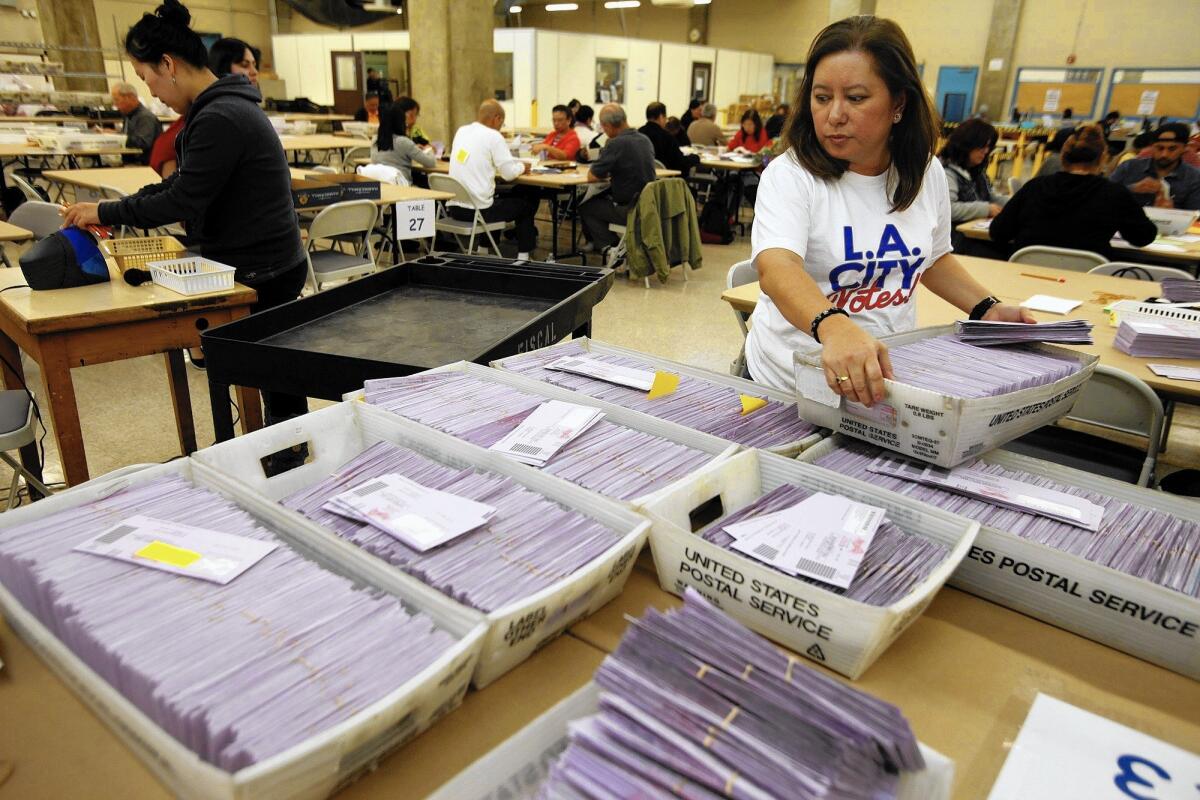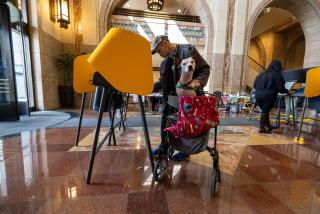L.A. election demonstrates the power of the few

- Share via
Los Angeles City Council members each represent districts of about 250,000 people. But three incumbents on Tuesday reclaimed their seats with what could end up being fewer than 10,000 votes apiece.
It was another dismal statistic in the city’s decades-long slide in voter turnout. What made Tuesday different was that those few voters who did cast ballots overwhelmingly approved a bid to reverse the trend by aligning municipal campaigns with state and federal elections.
How much of a turnout increase may come with the new election schedule is unclear, as are the costs of the shift. Even backers of the change acknowledged more work will need to be done.
“This was the important first step to take,” said Dan Schnur, co-chair of the committee that campaigned for city charter amendments on election timing.
“But it’s only a first step,” he said. “Ultimately it’s not just about convenience. It’s about motivation.”
As of Wednesday morning, city officials estimated that only 8.6% of registered voters had cast ballots, a figure that could rise somewhat as tens of thousands of remaining ballots are counted.
The more than 50% decline in L.A.’s turnout rate since the 1960s has been mirrored in other major cities, among them New York and Philadelphia, according to data compiled by Governing magazine.
“This is a huge thing that’s happening across the U.S.,” said Amaris Montes, a research and advocacy fellow with the election reform nonprofit FairVote. The result is that a small electorate — usually older and whiter — is making decisions that affect a more diverse municipal population, she said.
The L.A. charter amendments approved Tuesday with more than 75% of the votes cast were the centerpiece of a package of changes urged in the wake of a 2013 mayoral election in which about one in five eligible voters cast ballots.
L.A. leaders are continuing to examine other recommendations to increase turnout from a city commission, including hanging street banners to promote election day, putting voter registration forms on public counters and mounting registration drives in low-turnout neighborhoods.
They cite higher turnout in nearby cities, such as Alhambra and Santa Monica, that time their elections to state and national races. Turnout in some recent council races in those cities has been as high as 58% — twice that of the last closely contested mayoral race in Los Angeles.
“This very, very narrow and small electorate voted for something that will definitely change what that electorate looks like in future city elections,” said Raphael Sonenshein, executive director of the Pat Brown Institute at Cal State Los Angeles, who took no position on the measures.
Backers of the election changes say they will increase involvement of younger and minority voters, making the electorate more representative of the city as a whole.
But critics warn that local candidates and issues will be buried under an avalanche of campaigning for state and national contests, which appear higher on the ballot. Hans Johnson, president of the East Area Progressive Democrats, said campaigns will cost more because candidates will be competing at the same time as state and national contenders. As a result, the city will need to expand its pool of matching funds, he said.
“It’s a costlier environment in which candidates will need to get a message out,” he said.
Tuesday’s election may have been in large part about boosting turnout, but for those campaigning on the streets it was a chore to get people to the polls — even in hotly contested races such as the 4th Council District contest, in which 14 candidates were on the ballot.
Some campaign volunteers there said would-be voters complained that they were overwhelmed by the glut of glossy mailers and would hold off on voting until the May runoff.
As dusk fell on the final hours of campaigning, one of the candidates, David Ryu, hustled door-to-door in Koreatown, urging supporters whom he had previously contacted to get out and vote.
At one apartment, a man greeted him warmly but confessed that he hadn’t made it to the polls. Ryu pleaded with him to go, telling him he wouldn’t face any wait.
“Literally no one’s there,” he said. The man promised he would.
And this was a contest where every vote counted. Wednesday morning, only 61 votes separated Ryu and Tomas O’Grady from a spot in the runoff against front-runner Carolyn Ramsay.
Miracle Mile voter Eliza Fisher, a 23-year-old tutor, said Wednesday that she was embarrassed that she hadn’t cast a vote.
“I felt like I didn’t pay enough attention and it would be silly to vote without being informed,” Fisher said.
Ramsay supporter Patricia Casado expressed frustration with the low turnout. “The truth of the matter is, I don’t know why people are so lazy,” she said at an election night party for the candidate at her parents’ Hollywood cafe.
Ramsay was leading in semi-final returns with roughly 2,900 votes — meaning her campaign spent about $140 per vote.
One factor in Tuesday’s low turnout was the lack of issues that excited voters, experts said.
“People may think about legalizing marijuana or other kinds of social issues on a regular basis,” said Jessica Levinson, a professor at Loyola Law School-Los Angeles who studies election issues. “But whether or not we should link up city and state elections is something very few voters devote brain space to.”
Los Angeles city officials have been unable to estimate how much the shift will cost because the county is still developing a new voting system that it expects to roll out in three years. Los Angeles County Registrar-County Clerk Dean Logan said the city would pay part of the cost based on its turnout and the number of city issues on each ballot.
Making it more convenient to vote, as the charter amendments do, won’t change turnout in a dramatic way on its own, Logan said. Voters face long lines or other annoyances to cast votes in some areas where turnout is nonetheless high, he said.
The shift “has to be in parallel with ongoing community discussions of what the impact of a vote is,” Logan said.
Michael P. McDonald, an associate professor of political science at the University of Florida and a fellow at the Brookings Institution, said there was much greater participation in local elections in the 19th century, when political machines paid people for their votes or organized them to participate. Today, he said, there may not be much that local officials can do to increase turnout.
“Mail balloting seems to be one solution,” McDonald said. “The other is just holding an interesting election, but we really can’t dictate holding an interesting election.”
Times staff writer Abby Sewell contributed to this report.
More to Read
Sign up for Essential California
The most important California stories and recommendations in your inbox every morning.
You may occasionally receive promotional content from the Los Angeles Times.












